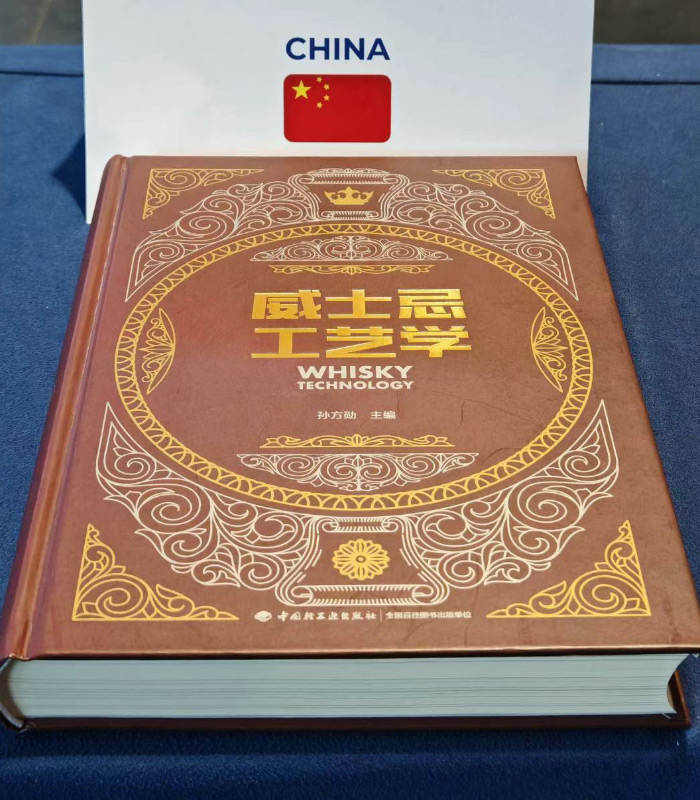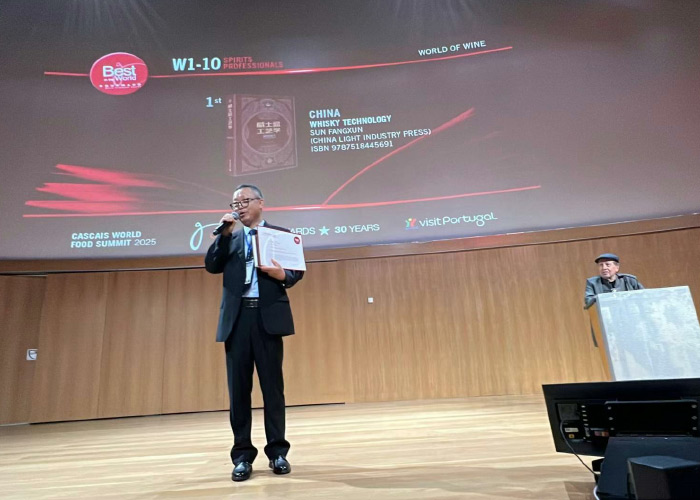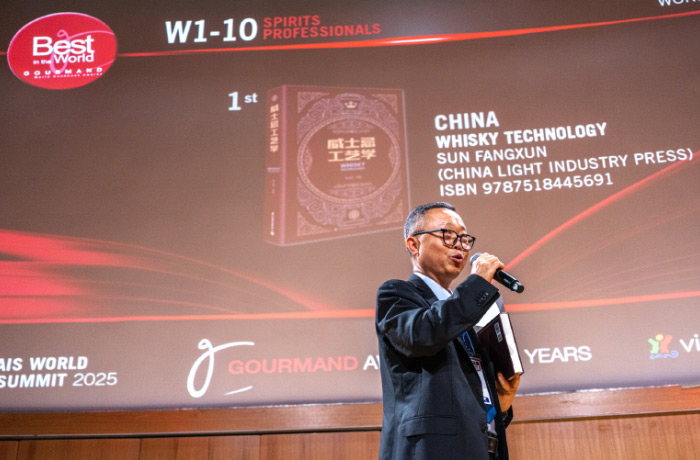6月20日,在葡萄牙首都里斯本埃斯托里国际会议中心举行的“世界美食美酒图书大奖赛”颁奖典礼上,由中国轻工业出版社出版,酿酒高级工程师、青岛葡萄酒厂原副总工程师孙方勋主编的《威士忌工艺学》,从全球众多参评作品中脱颖而出,荣获威士忌类(W-2-4)“世界最佳图书奖”。
本届美食美酒图书大奖赛共有六部威士忌类作品获奖,分别来自中国、德国、日本、土耳其、英国和美国。其中,《威士忌工艺学》列该类别榜首。

获奖作品《威士忌工艺学》。


孙方勋在颁奖典礼上发言。
《威士忌工艺学》主编孙方勋,山东即墨人,从事葡萄酒、威士忌酿造及历史文化研究近40年,系酿酒高级工程师,国家一级品酒师,国家级评酒委员,中国葡萄酒技术顾问委员会委员,国家葡萄酒及白酒、露酒产品质量监督检验中心专家委员会委员,国际葡萄酒与烈酒大赛裁判。曾担任青岛葡萄酒厂总经理助理、副总工程师,青岛华东葡萄酒有限公司首任酿酒师,中法合资青岛威廉·彼得酿酒有限公司总经理,现为青岛勋之堡酒业有限公司董事长。
孙方勋与威士忌结缘,始自20世纪70年代原轻工业部重点科研项目“优质威士忌酒的研究”。其时,落户于青岛的这一国家级项目,集结了国内最优秀的科研生产力量,对威士忌原料、糖化、发酵、蒸馏、熟成、勾兑和分析等均做出系统的科学研究,明确了一些影响麦芽威士忌、谷物威士忌的工艺路线。经过数年科学实验,从小试到中试,直到规模化生产,均完成了轻工业部下达的各项任务。
1982年,孙方勋调至青岛葡萄酒厂,先后担任分管技术的酿酒车间(下设威士忌研究班组)主任、技术处长、副总工程师等职务。1985年底,孙方勋公派至澳大利亚学习酿酒工艺, 90年代起,他多次应邀前去法国研究交流白兰地蒸馏技术,为我国烈酒发展及国家标准制定提供了许多宝贵的意见。
“实际上,早在20世纪70年代,我的导师,酿酒高级工程师、国家级评酒委员、青岛葡萄酒厂原总工程师,原轻工业部优质威士忌酒青岛研究小组负责人王好德先生就有一个愿望:多年后,将研究威士忌的艰辛过程予以总结,出版一本有关威士忌的书籍。前几年,因年事已高,导师的这一夙愿,连同多年来他收藏整理的珍贵资料一并转到了我这里,我开始了夜以继日的编写。”孙方勋回忆说。
在具体的书写过程中,孙方勋面临的最大问题,就是计量单位和外文名称的统一。“正规出版物的容错率是万分之一,书中涉及1.6万余个数据,其中很多是实验数据,当时采用的计量单位如加仑、斤等,并不是国际单位,只能逐一推算、验证,非常繁琐、耗时。”孙方勋说,从着手编写到最终完稿,他用了三年多时间。期间,每天早晨5点起床,除了吃饭、睡觉,日伏案十多个小时。
2025年年初,孙方勋主编的《威士忌工艺学》出版上市,社会反响良好。全书80万字,从历史、原料、工艺、风味和产区等方面,对威士忌做出全方位诠释,其中大量数据源于多年的科学生产实践,是非常宝贵的研究成果。
在颁奖现场,“世界美食美酒图书大奖赛”主席、创始人爱德华·君度先生,祝贺孙方勋“出版了这本内容全面且见解深刻的著作”。在颁奖词中,他对《威士忌工艺学》给予高度评价:“作者将自己40年来的实践经验与研究成果,精炼地浓缩于威士忌的世界之中。本书系统涵盖从原材料筛选、蒸馏工艺、陈酿管理、调配艺术,到不同产区的风格特征与风味解读等各个环节,显著提升了中国威士忌在全球版图中的地位。它成功填补了中国在威士忌生产技术领域的一项重要空白,无疑将对推动中国威士忌产业的未来发展起到关键作用。”
据悉,“世界美食美酒图书大奖赛”由爱德华·君度于1995年在法兰克福书展上创立,是目前唯一专注于全球美食美酒文化出版物的国际性竞赛,对所有语言书籍免费开放。大赛吸引了来自全球数十个国家和地区的作品参与,享有“美食美酒出版界奥斯卡”之美誉。
On June 20th, at the awards ceremony of the ‘Gourmand World Cookbook Awards’ held at the Estoril International Conference Center in Lisbon, Portugal, Whisky Technology published by China Light Industry Press and edited by Sun Fangxun—a wine-making engineer and former deputy chief engineer of Qingdao Winery—stood out among numerous global entries and won the ‘World's Best Book Award’ in the Whisky category (W-2-4).
A total of six whisky-related works from China, Germany, Japan, Turkey, the UK, and the US were awarded at this year's Gourmand World Cookbook Awards. Among them, The Technology of Whisky Production ranked first in the category.
Sun Fangxun delivered a speech at the awards ceremony.
Sun Fangxun, editor-in-chief of Whisky Technology, is a native of Jimo, Shandong. With nearly 40 years of experience in wine and whisky production as well as historical and cultural research, he holds the titles of Senior Wine-making Engineer, National First-Class Taster, and National-Level Wine Judge. He is also a member of the Chinese Wine Technical Advisory Committee and the Expert Committee of the National Supervision and Testing Center for Wine, Baijiu, and Liqueur Products, as well as a judge for the International Wine & Spirit Competition (IWSC).
Previously, he served as Assistant General Manager and Deputy Chief Engineer of Qingdao Winery, the inaugural winemaker of Qingdao Huadong Winery Co., Ltd., and General Manager of the Sino-French joint venture Qingdao William Peter Winery Co., Ltd. Currently, he is the Chairman of Qingdao Xunzhibao Wine Co., Ltd.
Sun Fangxun's connection with whisky began in the 1970s with the former Ministry of Light Industry's key scientific research project, ‘Research on Premium Whisky Production’. At that time, this national-level project, based in Qingdao, brought together China's top scientific and production talent to conduct systematic research on whisky raw materials, mashing, fermentation, distillation, maturation, blending, and analysis. The project clarified key technical approaches affecting malt whisky and grain whisky production. After years of scientific experimentation—from small-scale trials to pilot tests and eventually large-scale production—the team successfully fulfilled all tasks assigned by the Ministry of Light Industry.
In 1982, Sun Fangxun was transferred to Qingdao Winery, where he successively held positions as Director of the Wine-making Workshop (which included a dedicated whisky research team) overseeing technical operations, Head of the Technology Department, and Deputy Chief Engineer.
At the end of 1985, Sun Fangxun was sent to Australia on a government-sponsored program to study winemaking techniques. Starting in the 1990s, he was invited multiple times to France to research and exchange knowledge on brandy distillation technology. His contributions provided invaluable insights for the development of China's spirits industry and the formulation of national standards.
‘In fact, as early as the 1970s, my mentor, Mr. Wang Haode—a senior wine-making engineer, national-level wine judge, former chief engineer of Qingdao Winery, and head of the former Ministry of Light Industry's Qingdao Research Group for Premium Whisky—had a long-cherished wish: to one day summarize the arduous research process on whisky and publish a book on the subject. A few years ago, due to his advanced age, my mentor entrusted this unfinished mission to me, along with the valuable materials he had collected and compiled over the years. That’s when I began working day and night to write the book’,recalled by Sun Fangxun.
During the actual writing process, the biggest challenge was standardizing measurement units and foreign terminology. The acceptable error margin for formal publications is one in ten thousand. The book contains over 16,000 data points, many of which are experimental data. The units used at the time, such as gallons and jin [Chinese pound], were not international standards, so I had to recalculate and verify each one—an extremely tedious and time-consuming task, Sun Fangxun explained.
From the initial drafting to the final manuscript, the process took him over three years. During this period, he woke up at 5 a.m. daily and spent more than ten hours at his desk each day, with breaks only for meals and sleep.
In early 2025, Whisky Technology, edited by Sun Fangxun, was published and received widespread acclaim. The 800,000-word work provides a comprehensive interpretation of whisky, covering its history, raw materials, production techniques, flavor profiles, and regional characteristics. A significant portion of the data is derived from years of scientific research and production practices, making it an invaluable academic contribution to the field.
At the awards ceremony, Mr.Edward Cointreau, Chairman and Founder of the Gourmand World Cookbook Awards, congratulated Sun Fangxun for ‘publishing this comprehensive and insightful work’. In his commendation, he praised The Whisky Technology highly:
‘The author has distilled four decades of practical experience and research into the world of whisky. This book systematically covers every aspect—from raw material selection, distillation techniques, and maturation management to the art of blending, as well as the stylistic characteristics and flavor profiles of different regions—significantly elevating China's standing in the global whisky landscape. It successfully fills a critical gap in China's whisky production technology and will undoubtedly play a pivotal role in advancing the future development of the country's whisky industry’.
It is reported that the Gourmand World Cookbook Awards was founded by Edward Cointreau in 1995 at the Frankfurt Book Fair. As the only international competition dedicated to global food and wine culture publications, it is open to books in all languages free of charge. The awards have attracted entries from dozens of countries and regions worldwide and are hailed as the ‘Oscars of Food and Wine Publishing’.

